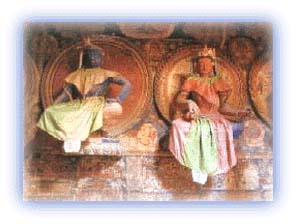Lahaul and Spiti
General Info
· Lahaul
· Baralacha Range
· Chandra Valley
· Bhaga Valley
· Keylong
· Chandra-Bhaga Valley
· Great Mountain Mass
· Lingti Plains
· Spiti
· Climate
· Kaza
· Pin Valley
Other Places of Interest
Passes
· Baralacha Pass
Rivers
· Chandra River
· Chandra - Bhaga
· Spiti River
Glaciers
· Bara Shigri Glacier
Lakes
· Chandratal Lake
· Suraj Tal Lake
People
· Lahaulas
· Tradition & culture
· Spiti
Religion
· Lahaul
· Spiti
Buddhism
· Lung pe Chhoi
· Superstitions and Beliefs
Fairs and Festivals
History
· Lahaul
· Spiti
Visual Delights

![]()
|
Hinduism A sizable part of the population consists of Hindus, who worship both the goddess Durga and the god Shiva. There are also many other local deities who are revered and worshipped. Another important mode of worship is that of traveling deities with fixed dates at different villages. A deity may be represented by a simple tree trunk adorned with pieces of multicolored cloth and with the head and legs of the deity indicated on them. The idol is taken out in a procession of many people and musicians. The procession goes to different villages where people worship the deity. This may continue for up to a month. |
In some cases, the deity is covered with a silver umbrella and is carried by two or three men on their shoulders followed by the procession. Each family has its own deity represented by an object which is worshipped on all important occasions and in many homes daily, usually with the smoke of juniper leaves.
The Hindus of Lahaul and Spiti also celebrate the traditional festivals such as Durga Pooja (worship of the goddes Durga) and Diwali (an important Hindu festival).
 |
| Clay figurines and frescoes in the Tabo Monastery. Tayul means the 'place that is chosen', and so it must be for the main prayer wheel at the gompa is said to rotate on its own accord at certain times. Credit: Discover India |
Buddhism
While Buddhists form a major constituent of the Spiti Valley,
they are present in mixed proportions in Lahaul. Often, a
village or a cluster of villages in Lahaul may comprise
Buddhists.
There are many Buddhist sects in the region. These include the Nyingmapa sect, which is believed to have been founded by the sage Padmasambhava in the 8th century in Tibet. Later, its followers came to Lahaul and Spiti. The Nyingmapa sect includes the lamas of the Kungri, Damphug, Kharchod and Sakeling gompas.
Another sect is the Gelugpa or Reformed sect, whose followers wear yellow robes and hence it is also known as the yellow sect.
All rights reserved